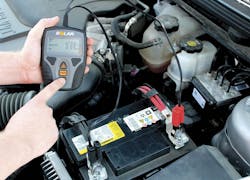When it comes to batteries, it’s a brave new world in a service bay. “The days of standard alternator output — it’s good if it is between XX.X and YY.Y volts — across all makes and models are over,” says Jim O’Hara, vice president of marketing for Clore Automotive Inc.
Conventional lead acid batteries are being replaced by absorbent glass mat (AGM) batteries.
More new technologies are on the horizon, namely enhanced flooded battery (EFB) technologies and lithium ion batteries.
“AGM continues to grow in the vehicle production world,” says John Munsell, battery product specialist for General Motor Corp.’s ACDelco brand. “It is estimated that by 2020 about 40% to 45% of all vehicles manufactured in the U.S. will have an AGM battery. EFB batteries are still not a big factor in the marketplace at this time. That could change over time as EFB might be used for second or third replacements in a start-stop vehicle as the vehicle ages.”
Marcel Ayasse, senior product manager of Robert Bosch LLC’s Automotive Aftermarket North America division, says EFB technology is slowly ramping up at select original equipment manufacturers. “However, it has not arrived in the independent aftermarket yet. AGM continues to grow in the North American market both on the original equipment side in combination with start-stop technology and in the aftermarket as an upgrade.”
Demand for AGM and EFB batteries increases significantly as start-stop technology gains momentum around the world, according to Dale Gospodarek of Johnson Controls Inc. Start-stop penetration for new vehicle production will reach 47% in the U.S., 82% in the European Union and about 50% in China by 2020, according to the company’s projections. In response to the anticipated demand, Johnson Controls is expanding AGM production capacity in the United States, Germany and China with $555 million in investments between 2011 and 2020.
In addition to OE requirements, AGM batteries are increasingly gaining in popularity as a premium choice for high-end and advanced fuel-efficient vehicles with large power demand. “It is well suited for people who seek greater reliability and longer life in auto batteries,” says Gospodarek, who is vice president of marketing and strategy for aftermarket U.S. and Canada in Johnson Controls’ Power Solutions division. “Electronic features such as DVD players, heated seats and audio systems all add increasing demands on a battery. With superior cycling capability, charge acceptance, and the ability to operate at a low state of charge, AGM is the technology of choice.”
O’Hara believes the biggest trend is continuing proliferation of the AGM battery as an OE option in both start-stop equipped and non-start-stop equipped vehicles. “This is a trend that is accelerating and will continue to impact the service environment going forward. All shops, regardless of area of specialization, will need to be familiar with AGM batteries, their characteristics, and what they require from a service perspective.”
Dedicated battery specialists
Are the new battery technologies creating a need for dedicated battery specialists in a shop’s service bays? That’s the question Modern Tire Dealer asked several battery manufacturers.
“Dedicated battery specialists aren’t required, but all technicians need to understand the characteristics and needs of the batteries they encounter,” says O’Hara. In addition, techs need to understand the battery in the context of the overall starting and charging system in which it is situated.
“Each model is equipped with a specific system with specific characteristics, so technicians need to approach each diagnostic event in the context of how that specific system is intended to operate.”
According to Gospodarek, under normal conditions most 12 volt automatic battery chargers will work on an AGM battery. “However, many newer battery chargers have settings designed specifically for AGM batteries.” He says the newer models of battery chargers are better for overall battery performance due to microprocessors that collect information from the battery and adjust the current and voltage accordingly.
Charging an AGM battery or replacing one in a start-stop vehicle is a different experience compared to a conventional technology. Finding the battery is the first step.
“When replacing an AGM or EFB battery in a start-stop vehicle, shop technicians not only need to be able to locate the battery, which can be under a hood, in a trunk or even under a seat. They also have to deal with new components like Battery Management Systems (BMS) or Intelligent Battery Sensor (IBS) that link the battery to the vehicle’s on-board electronics,” says Gospodarek.
He says Johnson Controls has developed a training program focused on educating technicians using a series of short video clips to help them correctly handle this new technology.
The technical replacement of an AGM battery is no different from a conventional flooded battery, according to Ayasse.
“There might be a battery sensor attached to the terminal connectors, but it doesn’t change the mechanics. The one thing to look out for is whether the car comes with a battery management system, which most of the newer ones do. If that is the case, the system needs to be recalibrated after a battery replacement if the exact 1:1 OE replacement isn’t used. This is typically doable with the standard test equipment a shop would use on the specific car. There should be no need for battery specialists.”
ACDelco advises techs to understand that there is a difference in the technology and that this requires some different care. “The tester needs to have an AGM capability, and most do, but the tech needs to acknowledge that they are testing an AGM battery,” says Munsell.
“Having the right charging equipment is very important in order for the battery to attain its full life. It is important for the techs and the shop owners to know that they must never put a conventional lead-acid battery into a start-stop application. Engineering analysis indicates that a conventional lead-acid battery will last four to six months in a start-stop vehicle.”
More sales opportunities
What do the new technologies mean for a shop’s revenue stream? Gospodarek says AGM batteries are a premium choice offering more value to consumers and more sales opportunities to shops. “The big revenue opportunity for shops is to test batteries on every vehicle they service.
“Research has proven that one in four batteries in vehicles today will be replaced in any given year.”
Shops using battery test equipment to diagnose the state of charge will identify more battery replacement opportunities, according to Gospodarek. “Communicating these results to consumers will result in more battery sales. AGM provides a great premium option for consumers, based on their vehicles’ electrical needs, but a consistent testing protocol will create more battery opportunities.”
O’Hara reminds shops to focus on the vehicle, not the type of battery that powers it. “Every non-electric vehicle that passes through a service bay has a starting battery of some sort. It has other electrical system components, such as a starter and alternator,” he says.
Regularly testing these components will yield opportunities to speak with customers about suboptimal components that are either in immediate need of attention or approaching the end of their useful life, starting with the battery, according to O’Hara.
“Having a strong working knowledge of these systems will allow shops to diagnose and resolve issues efficiently and effectively, allowing those repair events to be more profitable.”
Ayasse says newer technologies such as AGM definitely present a higher revenue opportunity.
“However, due to the longer lifetime, the shops are likely to make the same money or less on the product itself provided the car owner would have come back to the same shop when the conventional battery failed. The installation price depends on the battery management system, which will cost more if there is one.”
Get ready for lithium ion
Increasingly, shops will encounter lithium-based starting battery solutions, as well as lithium batteries incorporated in start-stop systems, according to Clore’s O’Hara.
“Like the AGM battery, lithium batteries will require equipment optimized for use with them, including battery testing and charging equipment. We are still some time away from lithium appearing regularly in service bays, but it is likely the next battery type service facilities will need to concern themselves with.”
What about batteries for hybrid, plug-in and electric vehicles? Says Gospodarek, “Hybrid, plug-in and electric vehicles have a future role in helping automakers meet environmental regulations, but will remain a relatively small part of today’s automotive market. The aftermarket hasn’t really shaped yet around these new technologies.”
The new battery technologies have different recycling requirements, too. It is very important that lead smelters receive only lead-acid and AGM type batteries, according to Munsell.
“Shop owners should be cautious when recycling batteries. If they are not sure if a battery can be recycled with lead-acid or AGM batteries, they should ask.
“Mixing of technologies such as lithium ion with lead-acid and AGM batteries can create serious and dangerous hazards at the smelter.” ■
About the Author

Ann Neal
Ann Neal is a former senior editor at Modern Tire Dealer.
